TOYOTA RAV4 PLUG-IN HYBRID 2021 Owners Manual
Manufacturer: TOYOTA, Model Year: 2021, Model line: RAV4 PLUG-IN HYBRID, Model: TOYOTA RAV4 PLUG-IN HYBRID 2021Pages: 666, PDF Size: 161.28 MB
Page 531 of 666
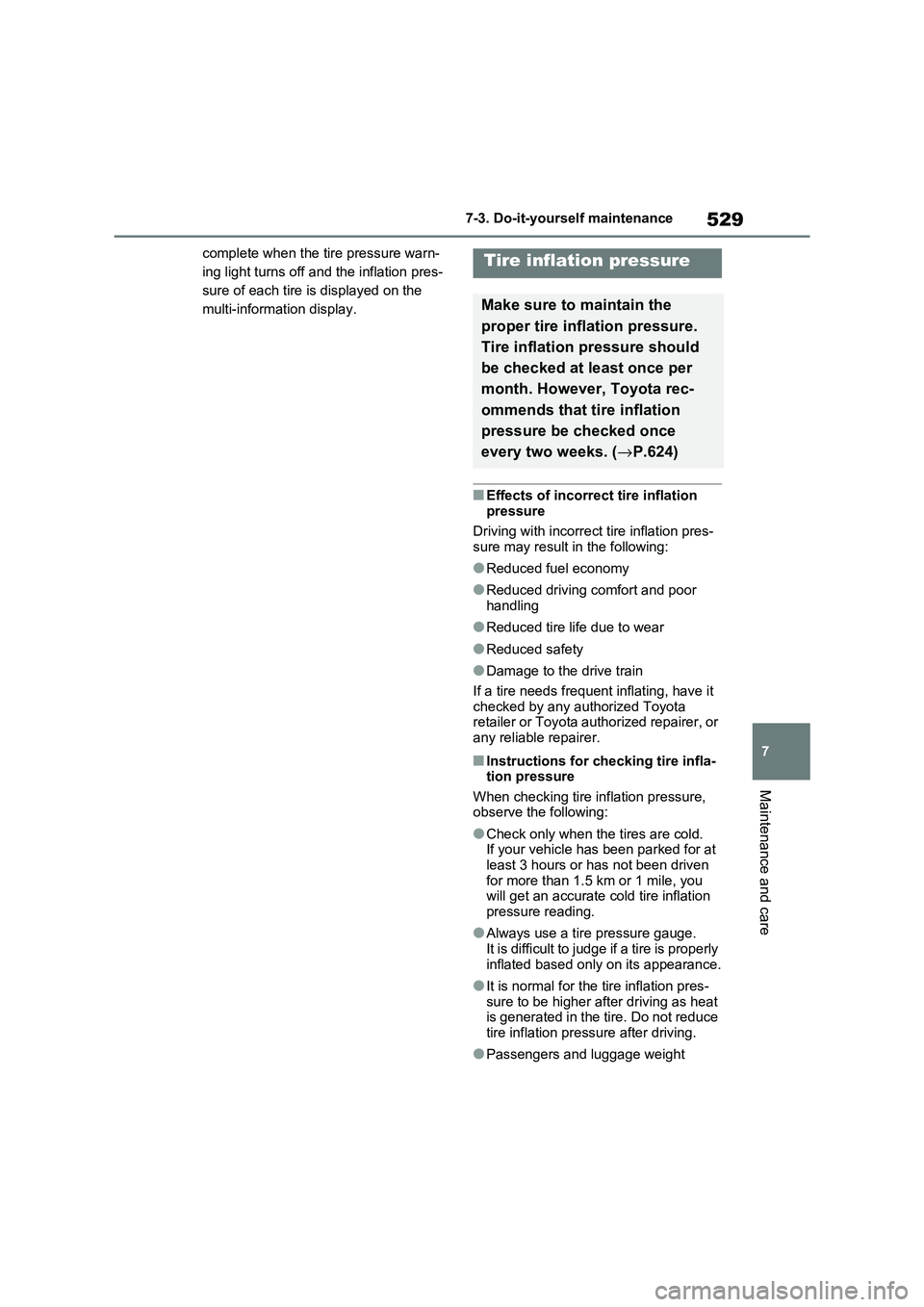
529
7
7-3. Do-it-yours elf maintenance
Maintenance and care
complete when the tire pressure warn-
ing light turns off and the inflation pres -
sure of each tire is displayed on the
multi-information display.
■Effects of incorrect tire inflation
pressure
Driving with incorrect tire inflation pres -
sure may result in the following:
●Reduced fuel economy
●Reduced driving comfort and poor handling
●Reduced tire life due to wear
●Reduced safety
●Damage to the drive train
If a tire needs frequent inflating, have it
checked by any authorized Toyota retailer or Toyota authorized repairer, or
any reliable repairer.
■Instructions for checking tire infla -
tion pressure
When checking tire inflation pressure, observe the following:
●Check only when the tires are cold.If your vehicle has been parked for at
least 3 hours or has not been driven
for more than 1.5 km or 1 mile, you will get an accurate cold tire inflation
pressure reading.
●Always use a tire pressure gauge.
It is difficult to judge if a tire is properly
inflated based only on its appearance.
●It is normal for the tire inflation pres-
sure to be higher after driving as heat is generated in the tire. Do not reduce
tire inflation pre ssure after driving.
●Passengers and luggage weight
Tire inflation pressure
Make sure to maintain the
proper tire inflation pressure.
Tire inflation pressure should
be checked at least once per
month. However, Toyota rec -
ommends that tire inflation
pressure be checked once
every two weeks. ( →P.624)
Page 532 of 666
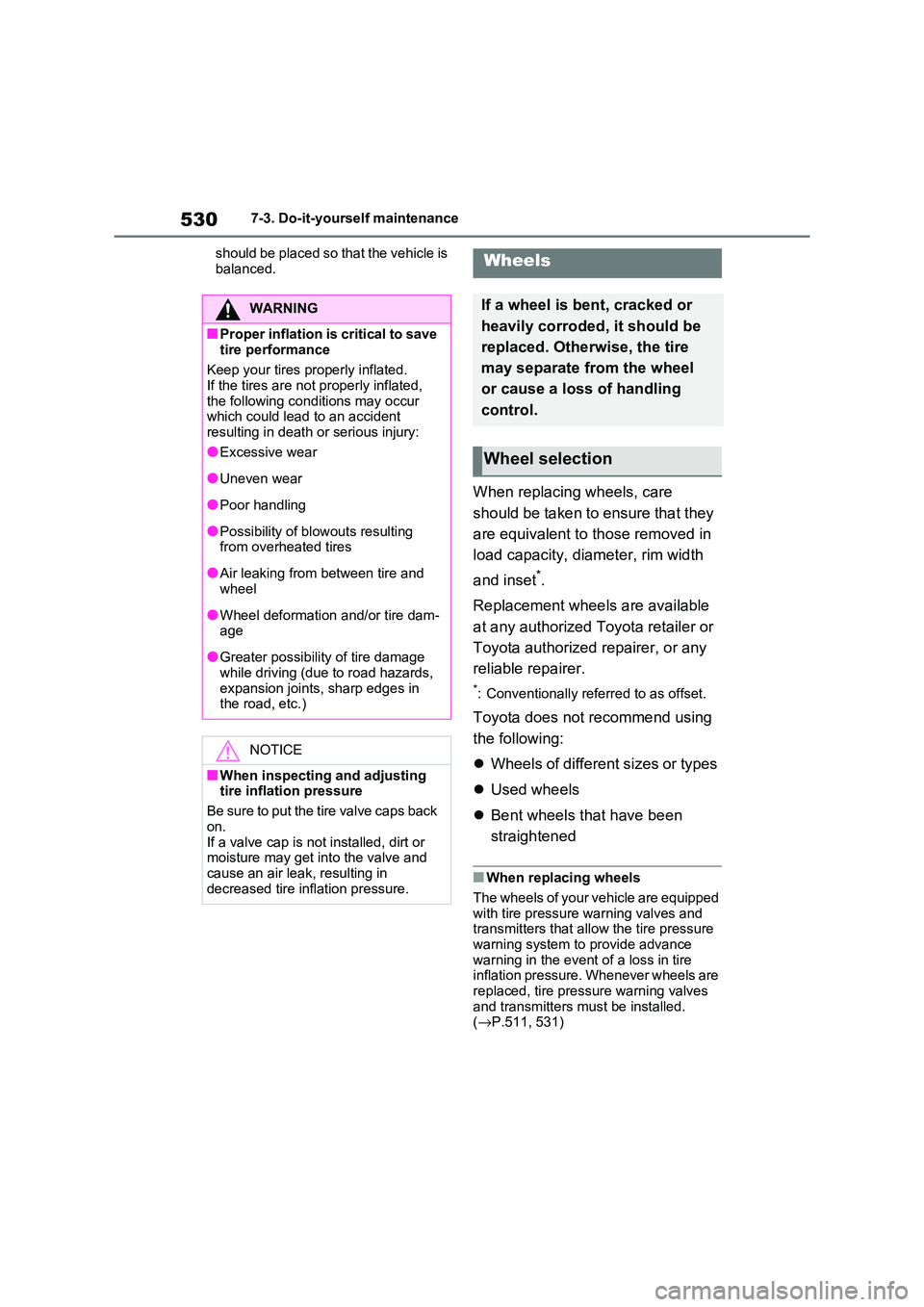
5307-3. Do-it-yourself maintenance
should be placed so that the vehicle is
balanced.
When replacing wheels, care
should be taken to ensure that they
are equivalent to those removed in
load capacity, dia meter, rim width
and inset*.
Replacement wheels are available
at any authorized Toyota retailer or
Toyota authorized repairer, or any
reliable repairer.
*: Conventionally referred to as offset.
Toyota does not recommend using
the following:
Wheels of different sizes or types
Used wheels
Bent wheels that have been
straightened
■When replacing wheels
The wheels of your vehicle are equipped with tire pressure warning valves and
transmitters that allo w the tire pressure
warning system to provide advance warning in the event of a loss in tire
inflation pressure. Whenever wheels are
replaced, tire pressure warning valves and transmitters must be installed.
( →P.511, 531)
WARNING
■Proper inflation is critical to save
tire performance
Keep your tires properly inflated. If the tires are not properly inflated,
the following conditions may occur
which could lead to an accident
resulting in death or serious injury:
●Excessive wear
●Uneven wear
●Poor handling
●Possibility of blowouts resulting
from overheated tires
●Air leaking from between tire and
wheel
●Wheel deformation and/or tire dam -
age
●Greater possibility of tire damage
while driving (due to road hazards,
expansion joints, sharp edges in the road, etc.)
NOTICE
■When inspecting and adjusting
tire inflation pressure
Be sure to put the tire valve caps back
on.
If a valve cap is not installed, dirt or moisture may get into the valve and
cause an air leak, resulting in
decreased tire inflation pressure.
Wheels
If a wheel is bent, cracked or
heavily corroded, it should be
replaced. Otherwise, the tire
may separate from the wheel
or cause a loss of handling
control.
Wheel selection
Page 533 of 666
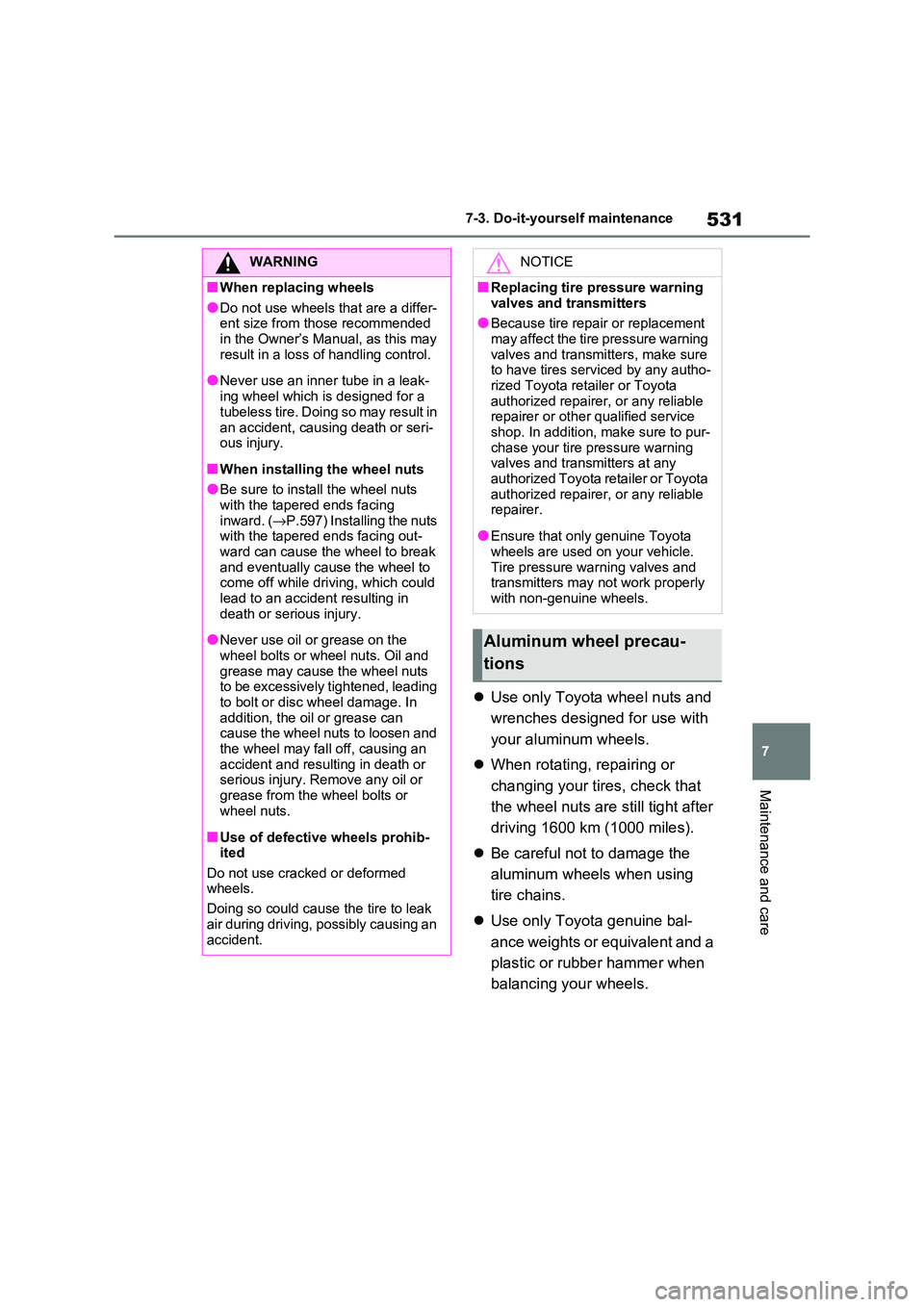
531
7
7-3. Do-it-yours elf maintenance
Maintenance and care
Use only Toyota wheel nuts and
wrenches designed for use with
your aluminum wheels.
When rotating, repairing or
changing your tires, check that
the wheel nuts are still tight after
driving 1600 km (1000 miles).
Be careful not to damage the
aluminum wheels when using
tire chains.
Use only Toyota genuine bal-
ance weights or equivalent and a
plastic or rubber hammer when
balancing your wheels.
WARNING
■When replacing wheels
●Do not use wheels that are a differ -
ent size from those recommended in the Owner’s Manual, as this may
result in a loss of handling control.
●Never use an inner tube in a leak -
ing wheel which is designed for a
tubeless tire. Doing so may result in
an accident, causing death or seri - ous injury.
■When installing the wheel nuts
●Be sure to install the wheel nuts
with the tapered ends facing
inward. ( →P.597) Installing the nuts with the tapered ends facing out -
ward can cause the wheel to break
and eventually cause the wheel to come off while driving, which could
lead to an accident resulting in
death or serious injury.
●Never use oil or grease on the
wheel bolts or wheel nuts. Oil and grease may cause the wheel nuts
to be excessively tightened, leading
to bolt or disc wheel damage. In addition, the oil or grease can
cause the wheel nuts to loosen and
the wheel may fall off, causing an accident and resulting in death or
serious injury. Remove any oil or
grease from the wheel bolts or wheel nuts.
■Use of defecti ve wheels prohib- ited
Do not use cracked or deformed
wheels.
Doing so could cause the tire to leak
air during driving, possibly causing an
accident.
NOTICE
■Replacing tire pressure warning
valves and transmitters
●Because tire repair or replacement may affect the tire pressure warning
valves and transmitters, make sure
to have tires serviced by any autho - rized Toyota retailer or Toyota
authorized repairer, or any reliable
repairer or other qualified service
shop. In addition, make sure to pur - chase your tire pressure warning
valves and transmitters at any
authorized Toyota retailer or Toyota authorized repairer, or any reliable
repairer.
●Ensure that only genuine Toyota
wheels are used on your vehicle.
Tire pressure war ning valves and transmitters may not work properly
with non-genuine wheels.
Aluminum wheel precau -
tions
Page 534 of 666
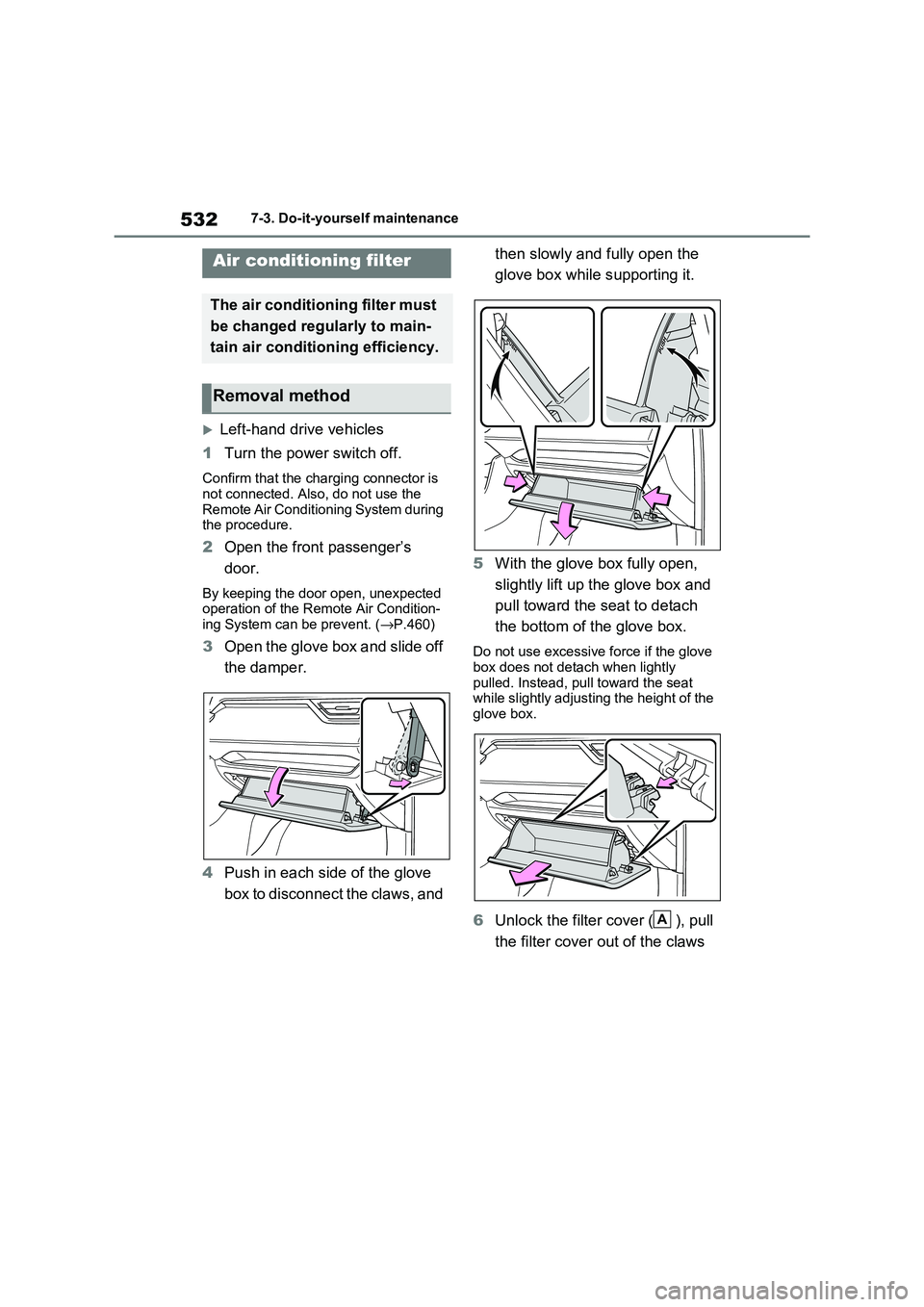
5327-3. Do-it-yourself maintenance
Left-hand drive vehicles
1 Turn the power switch off.
Confirm that the charging connector is not connected. Also, do not use the
Remote Air Conditioning System during
the procedure.
2 Open the front passenger’s
door.
By keeping the door open, unexpected
operation of the Re mote Air Condition- ing System can be prevent. ( →P.460)
3Open the glove box and slide off
the damper.
4 Push in each side of the glove
box to disconnect the claws, and
then slowly and fully open the
glove box while s upporting it.
5 With the glove box fully open,
slightly lift up the glove box and
pull toward the seat to detach
the bottom of the glove box.
Do not use excessive f orce if the glove
box does not detac h when lightly
pulled. Instead, pul l toward the seat while slightly adjusting the height of the
glove box.
6 Unlock the filter cover ( ), pull
the filter cover out of the claws
Air conditioning filter
The air conditioning filter must
be changed regularly to main -
tain air conditioning efficiency.
Removal method
A
Page 535 of 666
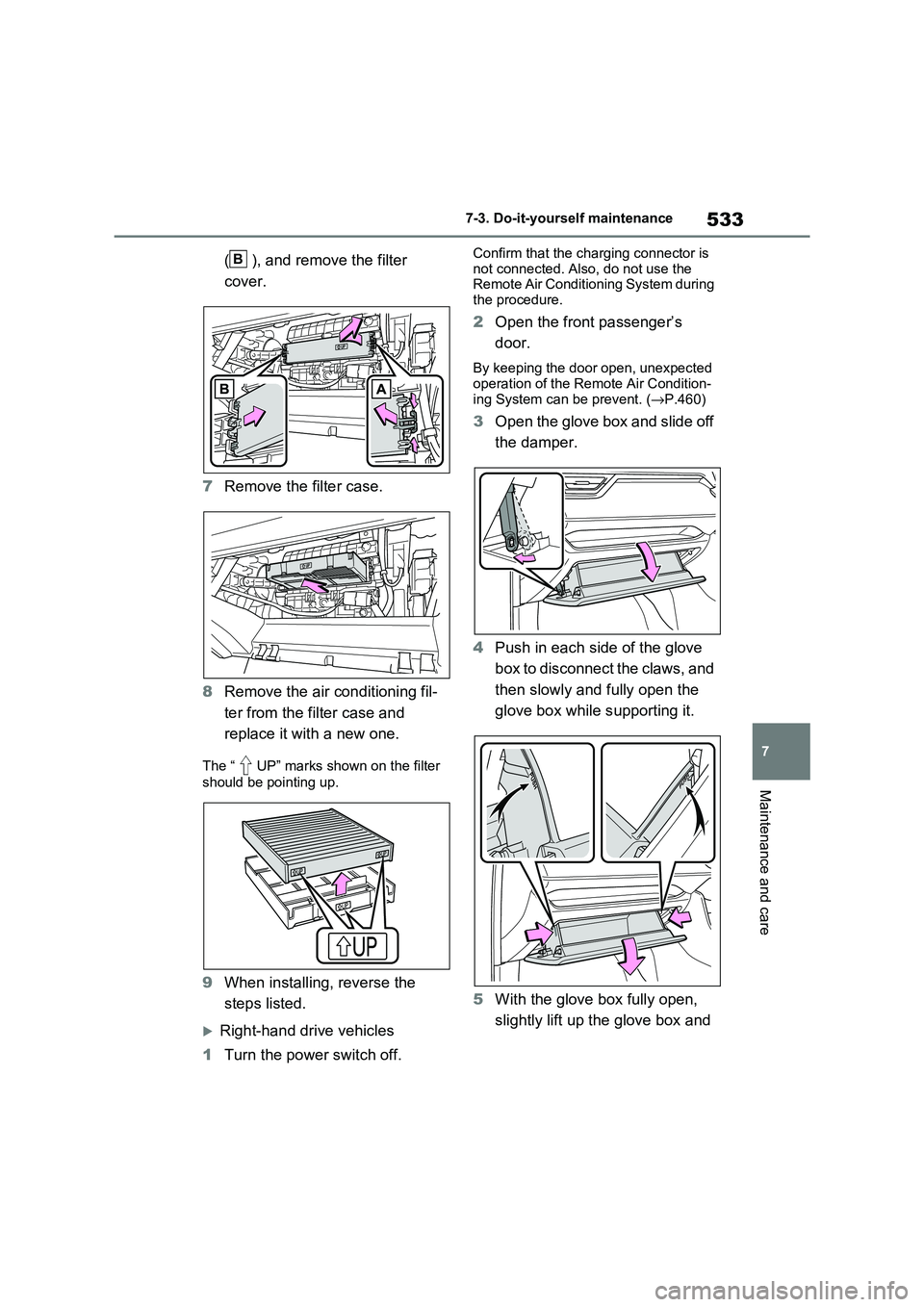
533
7
7-3. Do-it-yours elf maintenance
Maintenance and care
( ), and remove the filter
cover.
7 Remove the filter case.
8 Remove the air conditioning fil-
ter from the filter case and
replace it wit h a new one.
The “ UP” marks shown on the filter
should be pointing up.
9 When installing, reverse the
steps listed.
Right-hand drive vehicles
1 Turn the power switch off.
Confirm that the charging connector is
not connected. Also, do not use the Remote Air Conditioning System during
the procedure.
2 Open the front passenger’s
door.
By keeping the door open, unexpected
operation of the Remote Air Condition -
ing System can be prevent. ( →P.460)
3Open the glove box and slide off
the damper.
4 Push in each side of the glove
box to disconnect the claws, and
then slowly and fully open the
glove box while s upporting it.
5 With the glove box fully open,
slightly lift up the glove box and
B
Page 536 of 666

5347-3. Do-it-yourself maintenance
pull toward the seat to detach
the bottom of t he glove box.
Do not use excessive force if the glove
box does not detach when lightly pulled. Instead, pu ll toward the seat
while slightly adjusting the height of the
glove box.
6 Unlock the filter cover ( ), pull
the filter cover o ut of the claws
( ), and remove the filter
cover.
7 Remove the filter case.
8 Remove the air conditioning fil-
ter and replace it with a new
one.
The “ UP” marks shown on the filter
should be pointing up.
9 When installing, reverse the
steps listed.
■Checking interval
Inspect and replace the air conditioning
filter according to the maintenance schedule. In dusty areas or areas with
heavy traffic flow, early replacement
may be required. (For scheduled main - tenance information, please refer to the
“Toyota Service Bo oklet” or “Toyota
Warranty Booklet”.)
■If air flow from the vents decreases dramatically
The filter may be clogged. Check the fil -
ter and replace if necessary.
A
B
Page 537 of 666
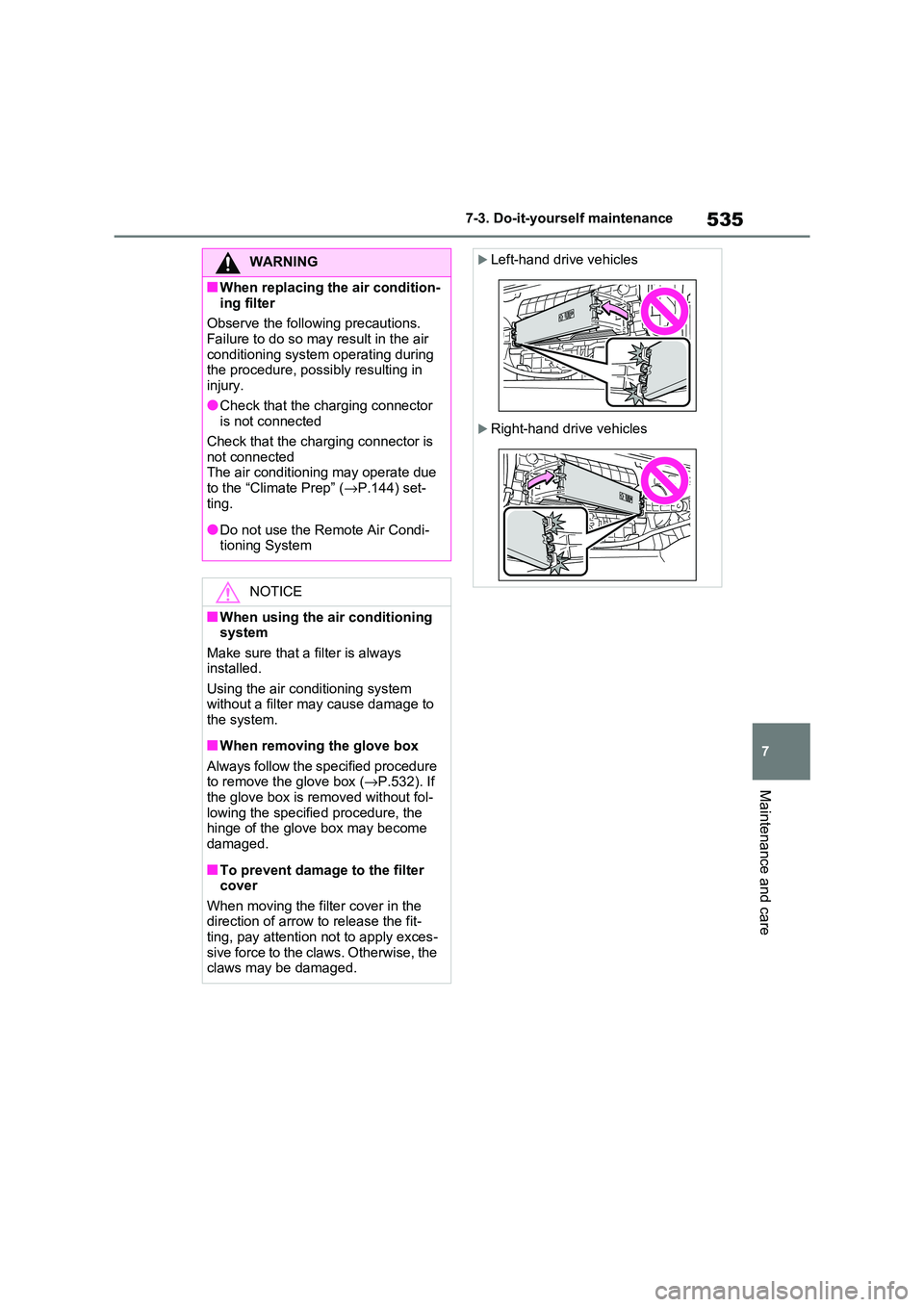
535
7
7-3. Do-it-yours elf maintenance
Maintenance and care
WARNING
■When replacing the air condition-
ing filter
Observe the following precautions. Failure to do so may result in the air
conditioning system operating during
the procedure, possibly resulting in injury.
●Check that the charging connector
is not connected
Check that the charging connector is not connected
The air conditioning may operate due
to the “Climate Prep” ( →P.144) set- ting.
●Do not use the Remote Air Condi - tioning System
NOTICE
■When using the air conditioning system
Make sure that a filter is always
installed.
Using the air conditioning system without a filter may cause damage to
the system.
■When removing the glove box
Always follow the specified procedure
to remove the glove box ( →P.532). If the glove box is removed without fol -
lowing the specifie d procedure, the
hinge of the glove box may become damaged.
■To prevent damage to the filter cover
When moving the filter cover in the
direction of arrow to release the fit- ting, pay attention not to apply exces -
sive force to the cl aws. Otherwise, the
claws may be damaged.
Left-hand drive vehicles
Right-hand drive vehicles
Page 538 of 666
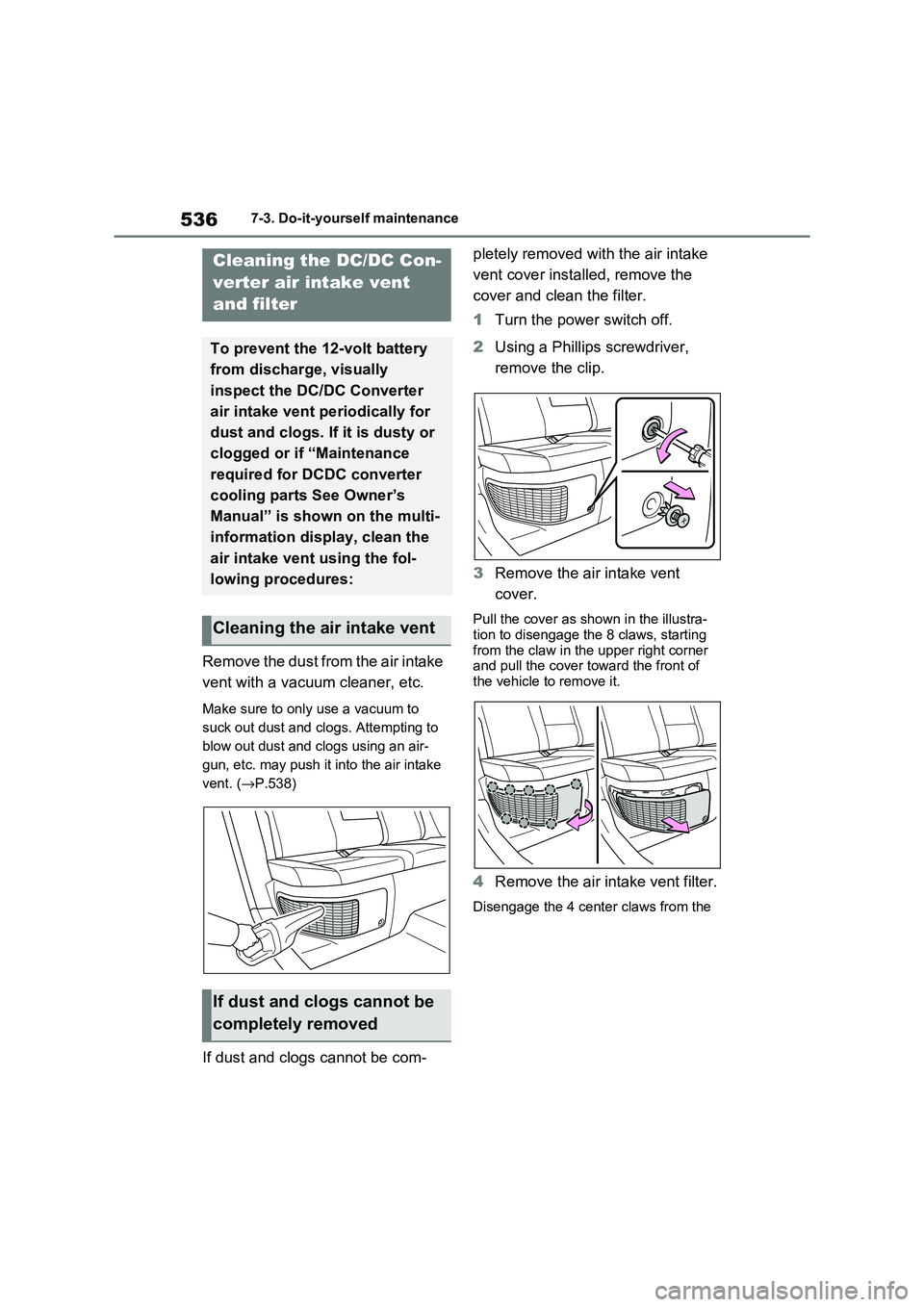
5367-3. Do-it-yourself maintenance
Remove the dust from the air intake
vent with a vacuum cleaner, etc.
Make sure to only use a vacuum to
suck out dust and clo gs. Attempting to
blow out dust and clogs using an air -
gun, etc. may push it i nto the air intake
vent. ( →P.538)
If dust and clogs cannot be com-
pletely removed with the air intake
vent cover installed, remove the
cover and clean the filter.
1 Turn the power switch off.
2 Using a Phillips screwdriver,
remove the clip.
3 Remove the air intake vent
cover.
Pull the cover as shown in the illustra - tion to disengage the 8 claws, starting
from the claw in the upper right corner
and pull the cover toward the front of the vehicle to remove it.
4 Remove the air intake vent filter.
Disengage the 4 center claws from the
Cleaning the DC/DC Con-
verter air intake vent
and filter
To prevent the 12-volt battery
from discharge, visually
inspect the DC/ DC Converter
air intake vent periodically for
dust and clogs. If it is dusty or
clogged or if “Maintenance
required for DCDC converter
cooling parts See Owner’s
Manual” is shown on the multi-
information display, clean the
air intake vent using the fol -
lowing procedures:
Cleaning the air intake vent
If dust and clogs cannot be
completely removed
Page 539 of 666
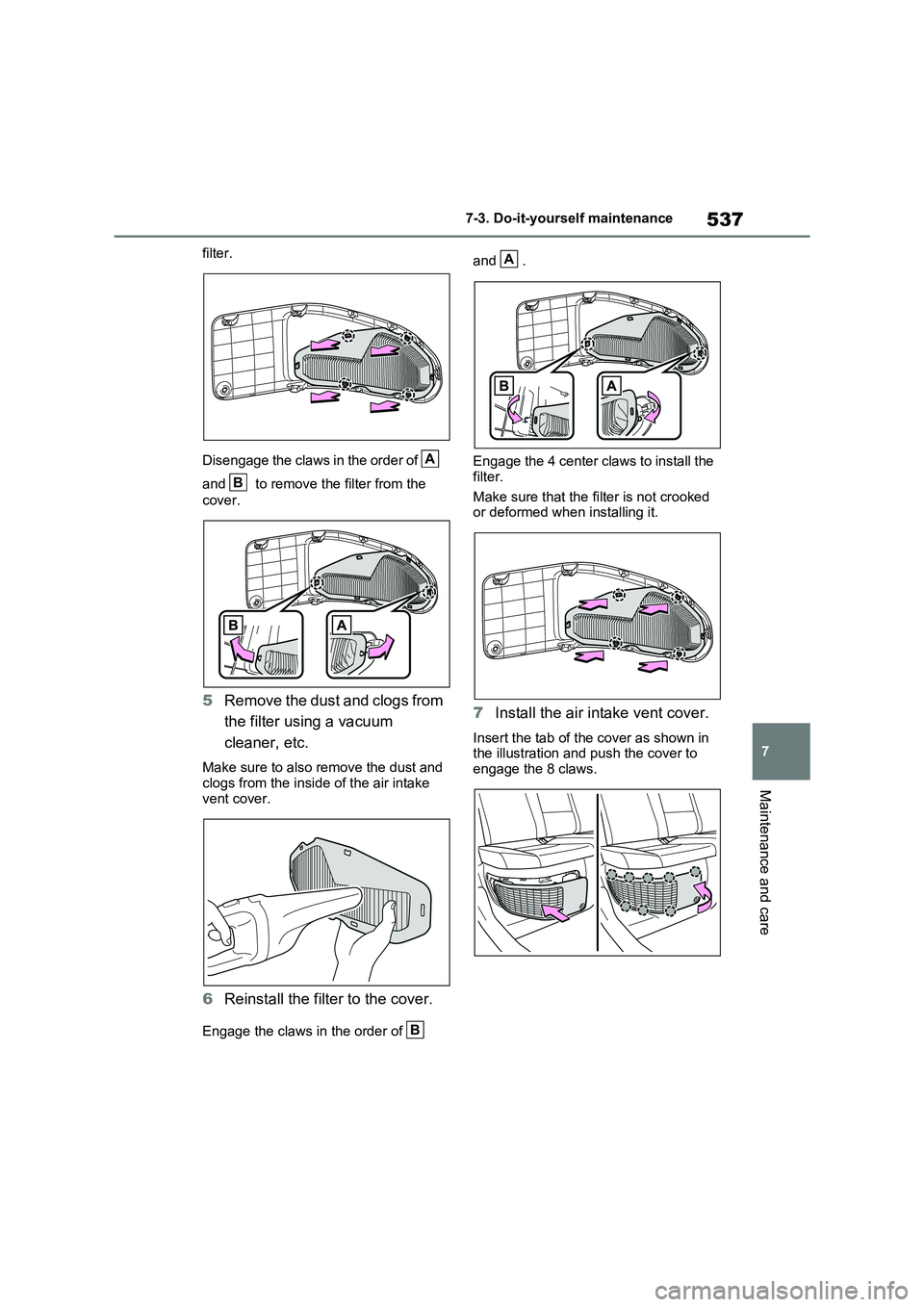
537
7
7-3. Do-it-yours elf maintenance
Maintenance and care
filter.
Disengage the claws in the order of
and to remove the filter from the
cover.
5 Remove the dust and clogs from
the filter using a vacuum
cleaner, etc.
Make sure to also remove the dust and
clogs from the inside of the air intake
vent cover.
6 Reinstall the filter to the cover.
Engage the claws in the order of
and .
Engage the 4 center claws to install the
filter.
Make sure that the f ilter is not crooked or deformed when installing it.
7 Install the air intake vent cover.
Insert the tab of the cover as shown in
the illustration and push the cover to engage the 8 claws.
A
B
B
A
Page 540 of 666
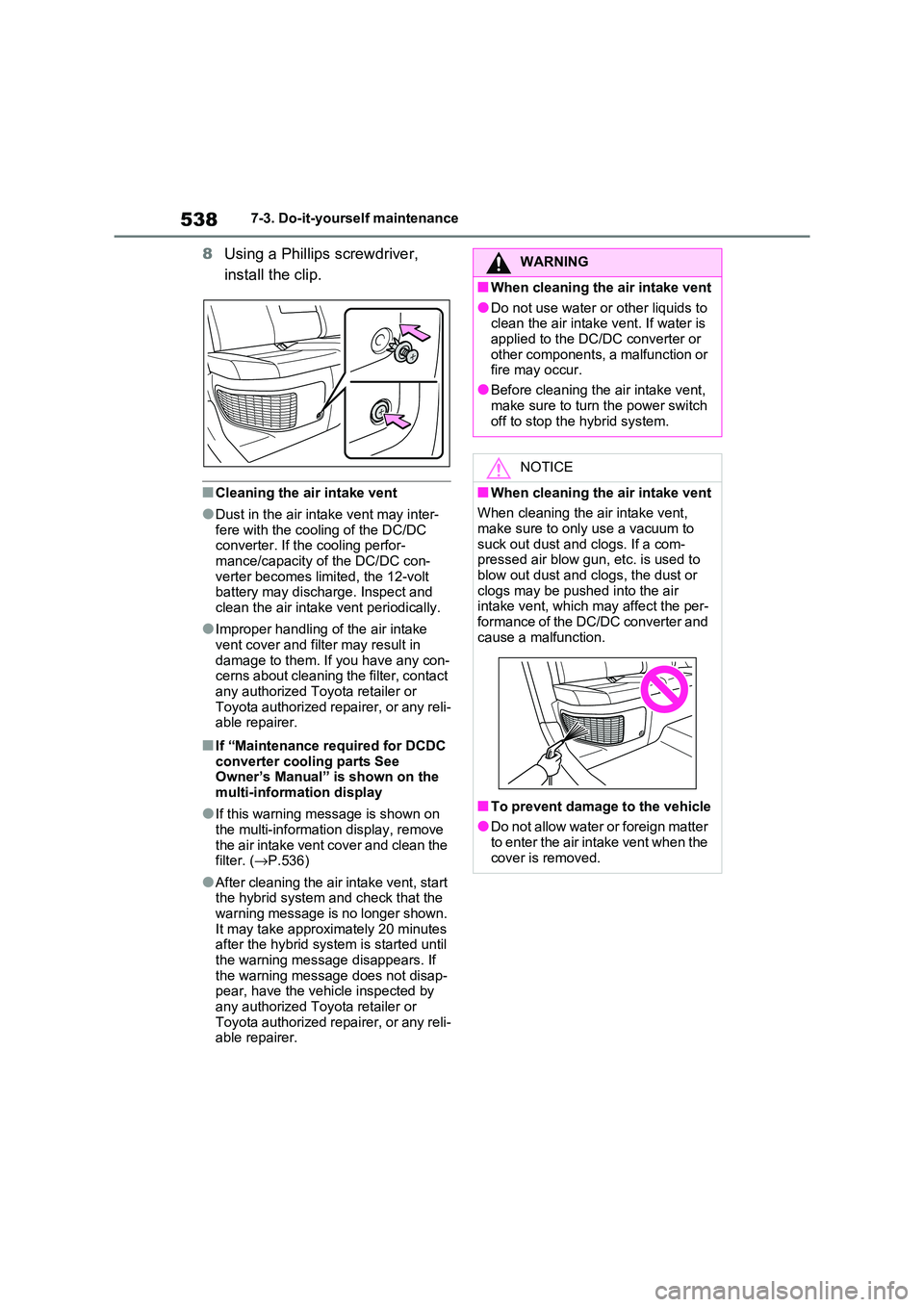
5387-3. Do-it-yourself maintenance
8Using a Phillips screwdriver,
install the clip.
■Cleaning the air intake vent
●Dust in the air intake vent may inter - fere with the cooling of the DC/DC
converter. If the cooling perfor -
mance/capacity of the DC/DC con - verter becomes limited, the 12-volt
battery may discharge. Inspect and
clean the air intake vent periodically.
●Improper handling of the air intake
vent cover and filter may result in damage to them. If you have any con -
cerns about cleaning the filter, contact
any authorized Toy ota retailer or Toyota authorized repairer, or any reli -
able repairer.
■If “Maintenance required for DCDC
converter cooling parts See Owner’s Manual” is shown on the
multi-information display
●If this warning message is shown on
the multi-informatio n display, remove
the air intake vent cover and clean the filter. ( →P.536)
●After cleaning the air intake vent, start the hybrid system and check that the
warning message is no longer shown.
It may take approximately 20 minutes
after the hybrid syst em is started until the warning message disappears. If
the warning message does not disap -
pear, have the vehicle inspected by any authorized Toy ota retailer or
Toyota authorized repairer, or any reli -
able repairer.
WARNING
■When cleaning the air intake vent
●Do not use water or other liquids to
clean the air intake vent. If water is applied to the DC/ DC converter or
other components, a malfunction or
fire may occur.
●Before cleaning th e air intake vent,
make sure to turn the power switch
off to stop the hybrid system.
NOTICE
■When cleaning the air intake vent
When cleaning the air intake vent,
make sure to only use a vacuum to suck out dust and clogs. If a com -
pressed air blow gun, etc. is used to
blow out dust and clogs, the dust or clogs may be pushed into the air
intake vent, which may affect the per-
formance of the DC/DC converter and cause a malfunction.
■To prevent damage to the vehicle
●Do not allow water or foreign matter to enter the air intake vent when the
cover is removed.